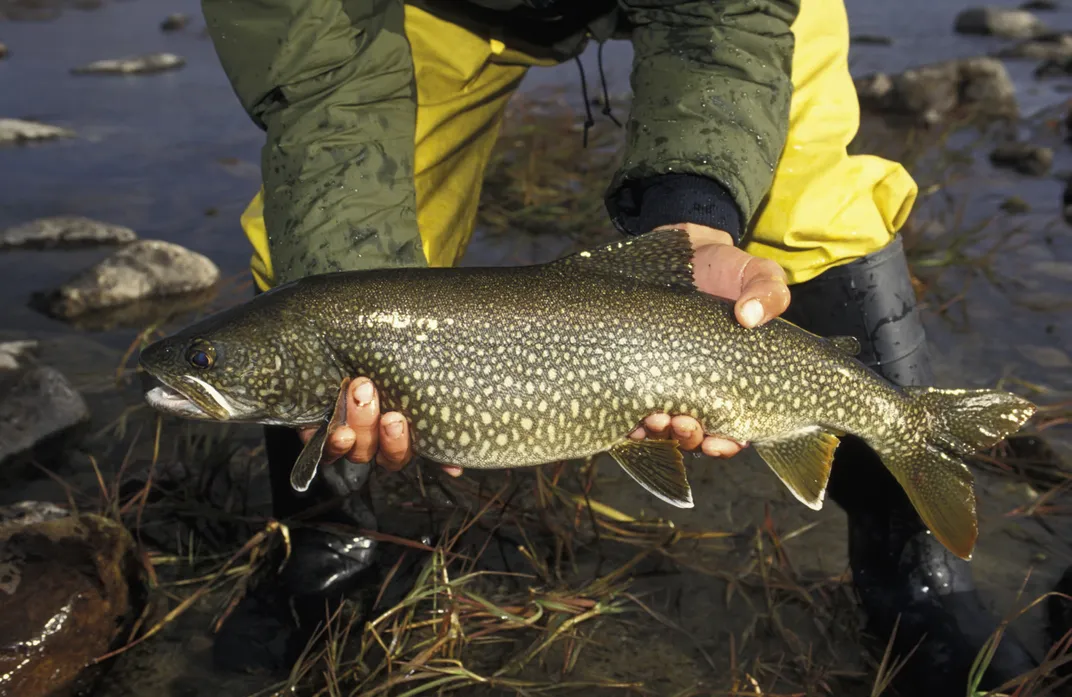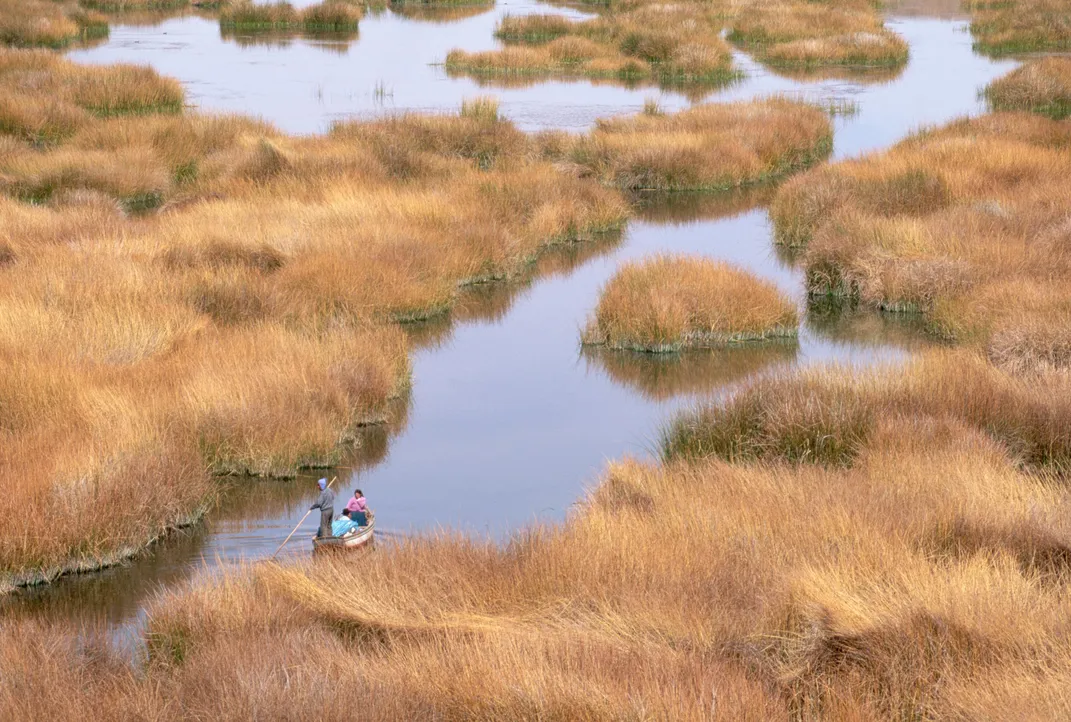What Are North American Trout Doing in Lake Titicaca?
The famous lake between Bolivia and Peru is struggling due to pollution, overfishing and the misguided intentions of almost 100 years ago
/https://tf-cmsv2-smithsonianmag-media.s3.amazonaws.com/filer/13/28/13286cc4-55cb-46ee-8514-7ba57b9c7d07/3331702002_f2c706ebef_o.jpg)
For the Inca, Peru’s famous Lake Titicaca was the birthplace of humankind. Straddling the border between Bolivia and Peru, it is the highest navigable lake in the world for large vessels and the biggest lake in South America by volume.
All this goes to show that it’s an important body of water. And when the sun sets over Lake Titicaca, it’s easy to see why it’s the backdrop to a creation myth. The burning orb dips quickly below the mountains and sends brilliant silver rays dancing over the water, blanketing the landscape in a soft glow.
The locals, many descendants from the region’s original settlers 4,000 years ago, rely on this land and the lake for their livelihoods, but both resources are fast deteriorating. The waning light falls on a shoreline strewn with debris—litter, feces and the long shadow of an animal carcass. Under the rippling water, the native fish are in danger of going extinct because of overfishing, invasive species and pollution.
“When you think of a lake, you think of this clear water, but [Lake Titicaca] is green,” says José Capriles, an anthropologist at the Universidad de Tarapacá in Chile. “It smells like sewage. It’s nasty.”
The fields surrounding Lake Titicaca are lush with potatoes and quinoa, and local restaurants reflect local produce. Quinoa soup and papas fritas (french fries) are served as a side to just about every dish—the main course being fish.
Lake Titicaca has two native fish genera: Orestias, which are called killifishes, and Trichomycterus, a type of catfish. There are two catfish species in the lake and at least 23 species of killifish, though some studies put the number much higher. But, at least as a tourist, it’s getting harder to find native fish on the menu.
Two fish species, humanto (Orestias cuvieri) and boga (Orestias pentlandii), are thought to have gone extinct, and all other native species of killifish, especially the ispi (Orestias ispi), are considered endangered. Instead, many restaurants serve trout and Argentinian silverside. Both are invasive species—the silverside is at least native to the same continent as Lake Titicaca, but the trout comes from the United States.

The North American lake trout came to South America with the blessing of Uncle Sam in the 1930s. Peruvian and Bolivian officials at the time saw the lake as an economic opportunity, and they reached out to the U.S. government for help. The United States responded by sending M.C. James from the Fish and Wildlife Service's Division of Fish Culture to Lake Titicaca.
James studied the area during the winter of 1935-36, a very short period, and then made a very consequential recommendation. He suggested—for reasons not clear today—stocking the lake with North American fish.
“A full generation may have passed before the results of this effort will have significance, but if the outcome is favorable [the Department of Fish Culture] will have rendered an outstanding service,” James wrote in a 1941 paper in the journal The Progressive Fish-Culturist.
Two years later, the U.S. government acted on James’ report. In total, the U.S. sent about 500,000 trout eggs and 2 million whitefish eggs. The whitefish eggs didn’t survive, but the trout flourished and are now one of the most invasive species in southern Peru. Lake Titicaca, the fabled birthplace of humanity, was irreversibly altered.
Trout have also infested lakes in Japan, Israel and Italy, where they endanger local fish populations by eating up all the available food.
“When people introduced the trout, the trout outcompeted the Orestias,” Capriles says. “Like any invasive species, there can be consequences.”
The Argentinian silverside was introduced to Lake Titicaca sometime in the 1950s. The fish has a silver stripe running the length of its body, and fish lips that rival those puckered in any selfie. Some say Bolivian boaters brought them to a nearby lake for sport fishing, and they made their way into Lake Titicaca via rivers. In 1955 the silverside, which can grow up to 20 inches long, established itself in the lake and reached a biomass of 20,000 tons. The rapid growth of both the trout and the silverside has been good for the economy but is displacing native species, Capriles adds.
Even after introducing invasive species into the lake, fishers continue to overfish. In the mid-1960s, the total annual commercial catch was 500 metric tons of fish, according to a 2006 study published in the Journal of Fish Biology. Since then, anecdotal evidence suggests that the catch has continued to decrease. If people fished the lake responsibly, they could get about 350 tons of fish, say the study authors. But there are few regulations governing Lake Titicaca in either Peru or Bolivia, and the rules that do exist aren’t enforced, Capriles says.

Pollution is also a concern. Lake Titicaca is only about 600 feet at its deepest, and climate change has dried up several areas near the shore, concentrating the pollutants dumped there by factories, mining activities, farming and general industry.
“Anything that occurs within that watershed eventually gets washed from the rivers into the lake,” says Christine Hastorf, a food anthropologist at the University of California Berkeley. “You have an industry chopping wood or using mercury to mine for gold; it gets into the lake.”
Farmers and ranchers up in the surrounding Andes also add to the pollution. Instead of using manure to help grow their crops, many agriculturalists have switched to fertilizer at the urgings of North American NGOs, Hastorf adds. These chemicals are washed out of the soil after it rains and into the lake, which is bad for marine animals.
The foreign nutrients can also cause large, green algae blooms that suck up all the oxygen in the water. These algae blooms can cause “dead zones” and often release poison into the water that’s gram-per-gram the toxicity of cobra venom, says Wayne Wurtsbaugh, a limnologist at Utah State University.
“That algae uses up oxygen, and if you don’t have oxygen there, you don’t have a healthy ecosystem,” he adds. “Algae produce toxins that can be a problem for drinking water. [Animals] come in, drink it and die.”
This June, authorities from both countries met in La Paz and agreed to work together to fix the lake’s environmental problems. However, the projects they must undertake to truly clean the lake will cost tens of millions of U.S. dollars. Even if funds are channeled toward a Lake Titicaca restoration program, it’s conceivable that government corruption and civil unrest could stall any projects.
This means it is possible that Lake Titicaca will give birth to an effective partnership between Bolivia and Peru—a partnership that could one day save this natural resource—but it’s unlikely, says Capriles.
“Last year the pollution in Lake Titicaca became a public issue,” he adds. “There were campaigns to clean up the river and [make] tighter regulations, but it's very difficult to monitor these issues.”
/https://tf-cmsv2-smithsonianmag-media.s3.amazonaws.com/accounts/headshot/Photo_Bloudoff.jpg)
/https://tf-cmsv2-smithsonianmag-media.s3.amazonaws.com/accounts/headshot/Photo_Bloudoff.jpg)